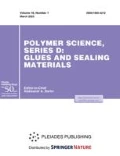Abstract
The properties of VK-98 epoxy film glue and its application for binding multilayer (honeycomb) structures (wing panels, wing mechanization elements, etc.) manufactured by molding jointly with coverings made of prepregs based on VSE-1212 binder are presented. The study of the kinetic parameters of the curing process of VK-98 glue and VSE-1212 binder showed that the gluing and molding processes of PCM items containing these materials can be performed by a single technological cycle. It was established by DSC that the pot life of VK-98 glue is no less than 15 days at room temperature. It was shown that glued joints of VKU‑39 carbon plastic based on VSE-1212 binder after the effect of both artificial tropical conditions and salt mist almost do not change their strength, while VK-98 glue can be used in the temperature range from ‒60 to +120°C and for a short period at 150°C.




Similar content being viewed by others
REFERENCES
E. N. Kablov, “Innovations of the All-Russian Institute of Aviation Materials (VIAM) as part of implementing the Strategic Directions of Development of Materials and Technologies of Their Processing for the Period up to 2030,” Aviats. Mater. Tekhnol., No. 1, 3–33 (2015). doi https://doi.org/10.18577/2071-9140-2015-0-1-3-33
E. N. Kablov, L. V. Chursova, A. N. Babin, R. R. Mukhametov, and N. N. Panina, “Developments of the All-Russian Research Institute of Aviation Materials in the field of melt binders for polymer composite materials,” Polim. Mater. Tekhnol. 2 (2), 37–42 (2016).
K. I. Donetskii and A. V. Khrul’kov, “Green chemistry principles in promising technologies for manufacturing products from PCM,” Aviats. Mater. Tekhnol., No. S2, 24–28 (2014). doi https://doi.org/10.18577/2071-9140-2014-0-s2-24-28
A. E. Raskutin, “Structural carbon fiber composites based on new melt-type binders and PORCHER fabrics,” Nov. Materialoved., No. 5 (2013). http://materialsnews.ru/plugins. Accessed November 5, 2017.
A. O. Kurnosov, D. A. Mel’nikov, and I. I. Sokolov, “Fiberglass of structural design for aircraft industry,” Tr. Vseross. Nauchno-Issled. Inst. Aviats. Mater., No. 8 (2015). doi https://doi.org/10.18577/2307-6046-2015-0-8-8-8
N. F. Lukina, L. A. Dement’eva, A. P. Petrova, T. A. Kirienko, and L. V. Chursova, “Adhesive binders for PCM components of a cellular structure,” Polym. Sci., Ser. D 9 (4), 387–391 (2016).
T. A. Kirienko, N. F. Lukina, K. E. Kutsevich, and A. P. Petrova, “A study of the rheological properties of adhesive binders,” Polym. Sci., Ser. D 9 (3), 295–297 (2016).
E. N. Kablov, L. V. Chursova, N. F. Lukina, K. E. Kutse-vich, E. V. Rubtsova, and A. P. Petrova, “A study of epoxide–polysulfone polymer systems for high-strength adhesives of aviation purpose,” Polym. Sci., Ser. D 10 (3), 225–229 (2017).
A. N. Babin, M. A. Guseva, T. A. Grebeneva, and A. I. Tkachuk, “Investigation of the rheological and structural characteristics of epoxy binders modified by polyisocyanate,” Tr. Vseross. Nauchno-Issled. Inst. Aviats. Mater., No. 1 (2016). doi https://doi.org/10.18577/2307-6046-2016-0-1-90-98
A. N. Babin, M. A. Guseva, M. A. Khaskov, and A. I. Tkachuk, “The study of the process of combining epoxy oligomers with thermoplastic modifiers,” Mekh. Kompoz. Mater. Konstr., No. 14, 524–535 (2016).
L. A. Dement’eva, K. E. Kutsevich, N. F. Lukina, and A. P. Petrova, “The study of adhesive binders for the production of polymer composite materials,” Nov. Materialoved., No. 2, 24–35 (2016).
K. S. Mishurov, N. G. Faizrakhmanov, and N. V. Ivanov, “Effect of the environment on the properties of carbon fiber plastics VKU-29,” Tr. Vseross. Nauchno-Issled. Inst. Aviats. Mater., No. 8 (2017). doi https://doi.org/10.18577/2307-6046-2017-0-8-8-8
R. R. Yakhikhanov and E. V. Matygullina, “Estimation of the effect of the gluing regime on the characteristics of carbon fiber claddings in cellular structures,” Master’s J., No. 1, 179–184 (2016).
ACKNOWLEDGMENTS
This work was performed within the implementation of “Strategic Development Trends of Materials and Their Processing Technologies for the Period Until 2030” [1] regarding the development of the promising innovative notions “Light Structures” and “Promising Engine” within the Strategic Trend 15. “Nanostructured Amorphous Materials and Coatings”: Integrated Problem 15.1, “Multifunctional Gluing Systems.”
Author information
Authors and Affiliations
Corresponding author
Additional information
Translated by E. Petrova
Rights and permissions
About this article
Cite this article
Tkachuk, A.I., Rubtsova, E.V., Gurevich, Y.M. et al. VK-98 Structural Film Glue. Polym. Sci. Ser. D 12, 29–34 (2019). https://doi.org/10.1134/S1995421219010210
Received:
Published:
Issue Date:
DOI: https://doi.org/10.1134/S1995421219010210



